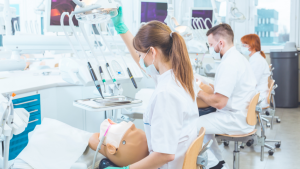Managing the professional development of your team

‘Opening new career paths in our industry is vital’: This month, Ashley Byrne discusses the importance of investing in education and professional development in a dental lab.
Professional development has always been one of the most important factors in running my lab. From day one, we have invested heavily in education and team development. We’ve had outstanding results with a significant and positive impact at my lab – but that doesn’t mean it’s been easy.
Paying for an education course or allocating some training time simply isn’t enough. When a person wants to see personal and professional development, decisions that affect the running of the lab need to be made and this can be painful, especially when your lab is running well.
What do I mean by that? Well, let’s take an example from my own dental lab…
Models made to perfection
Tim is a machine of an employee – not literally, but his model work was so consistently perfect that you would honestly think a machine had made them.
For around eight years I had perfect models – not a bubble or a mark, nor a missing pin, and articulations were finished so beautifully that you could almost see your reflection in the plaster.
Yet gypsum models have no future, which means Tim had no future. I advertised for a model technician and I got zero applicants. Three months went by and still there were zero. You could argue the best for the company was to leave Tim in his role as we had no replacement and models are safe for a few more years, so what’s the issue?
The issue is when people have a limited future or see no personal development, they leave. If Tim left, I would have no model room and would have lost a great member of Team Byrnes. It’s a double whammy lose-lose situation for everyone.
‘Extremely challenging’
So, how did we redefine our future? We employed two trainees with zero experience and gave Tim two months to train them, while in parallel preparing to switch Tim to a CAM role with a clear training and development plan.
How did it work out? I’ll be upfront here: it was extremely challenging! Models full of bubbles, implants mis-ordered, soft tissue stuck to silicones, impressions in wrong boxes, and my immaculate model room that looked like a Michelin star kitchen now looked like someone had set off a gypsum bomb in it.
Tim was now learning CAM, but had barely used a PC, so we had to teach him from scratch as well. Why put your company through that pain just to ensure someone has a future? I won’t deny it, I was questioning my thought process for a few good minutes.
The gains outweigh the pains
Now let’s look at the lab today, several years on. I once again have an immaculate model room run by Dawn, who came to me for a career change after years working in a care home. She takes great pride in her job and delivers beautiful models time and time again.
Ali assists her and while he helps in the model room, and he’s also learning to print soft tissues and help distribute them. As gypsum work reduces, he will then help train Dawn as she transitions from analog to digital processes.
Tim runs my CAM department, which hosts three Carbon printers and two milling machines, and we turn out as many as 1,200 parts per day perfectly.
Everyone has a future, my CAM department runs near faultlessly, and the gains far outweigh the pains. This is just one example of why ensuring people have a development plan is critical to labs moving forward, and it’s one of many examples at Byrnes where moving people from doing their job incredibly well can ensure they do their next job even better.
Creating new career paths
Leanne is another example. As my operations leader she was incredible in her role leading my admin team, but she also felt regret that she never went to university, so we changed that. We funded her degree in business administration and she excelled throughout her studies, while discovering a passion for learning and development.
So, while I lost that operations leader role, creating a path and moving Leanne into our people lead role retained a great team member who now heads up our learning and development and our HR at Byrnes.
Yes, it was another challenging process of losing someone in a key role, but that then gave Amelia her opportunity to step up to the operations leader role.
The last few years I put a lot of the success of the development of our people down to Leanne’s work and having her in a role dedicated to ensuring people reach their potential and remain engaged at work. (I would also include my own personal development in that recognition).
The importance of professional development
While I am now a large enough business to justify a full-time person in a learning and development role, I would also admit that reflectively, I wish I had someone part-time when I was much smaller, or that I had delegated that task sooner.
At Byrnes we ensure every team member in every role has a personal development plan (PDP), be that GDC-registered or not. And this includes everyone in technical, operations and business roles. Leanne will sit down with each team member every six months and take the time to listen to them about their roles, and to ensure nobody is getting bored or frustrated.
Some people prefer to continue doing what they do, others want some development by education, and others want a complete change. But what’s important is that we take the time to listen to each person and write a custom PDP for everyone.
Generic plans never maximise the true capability of people. Leanne will then discuss those plans and we work with internal and external educators to achieve the development goals.
Professional development also does not always come from a PDP. Myself, Alison, and my leadership team also observe, listen, and try to identify skill sets in people that have not yet come to the surface…
Forward-thinking
We spoke about Tim in the earlier part of this article and in truth, Tim’s switch to CAM was not via a PDP or even Tim’s suggestion. He was highly organised, tidy, kept equipment pristine in a dusty and challenging environment, and had an incredible eye for detail.
While Tim saw that being perfectly suited to models, we saw it as a great opportunity to learn and run the expanding CAM department, which at the time was run by our CAD team. With hundreds of pucks of different types, shades, and thickness, with printers that use multiple materials, and requiring excellent file management, it was clear to us that Tim would be great in this role.
Yet Tim had barely turned on a computer and had never worked in CAD or anything PC-related before. We never saw that as a hurdle, yet it would have been all too easy to say, ‘Tim doesn’t know how to use a PC’ or ‘Tim’s going to need a lot of training’. While both of those aspects are correct, they are also both mere minor setbacks that can be planned through and trained for – with a good mindset.
Opening new career paths in our industry is vital. The way I learnt to make a crown or denture is now so utterly different. At Byrnes, we no longer train how to wax or carve a crown, we don’t train gypsum model making, and we don’t train flasking and packing to our new trainees. These are all processes in my lab that have gone or will phase out soon, so why waste that training?
I need a forward-thinking team with cutting edge skills, so we look reflectively at those training skills.
Don’t overlook learning and development
There’s a question I’ve used in my slides for over 10 years, and that is ‘what if you train people and they leave?’. It’s very simply answered by ‘what if you don’t train them and they stay?’
Even a decade on, this mindset holds true for me. If I spend £10k training someone and they leave, that is a fault that lies entirely with myself. I obviously didn’t give them enough opportunity or I didn’t satisfy their needs. Education is expensive and it’s quite the investment, but it’s an investment that continues to pay off, day after day, and it’s important that we develop the team to benefit the company.
It encourages people to stay, it ensures we improve as a company, and it keeps people engaged. Engaged people are vastly more productive and motivated, and invested wisely, training costs soon hold their value. So think carefully about your team and ensure you manage that personal and professional development.
Learning and development is often overlooked in many industries, including dental technology, and it can be difficult to justify a resource at the expense of a technician or piece of equipment.
Catch up with previous columns from The Lab Expert:
Follow Dentistry.co.uk on Instagram to keep up with all the latest dental news and trends.







